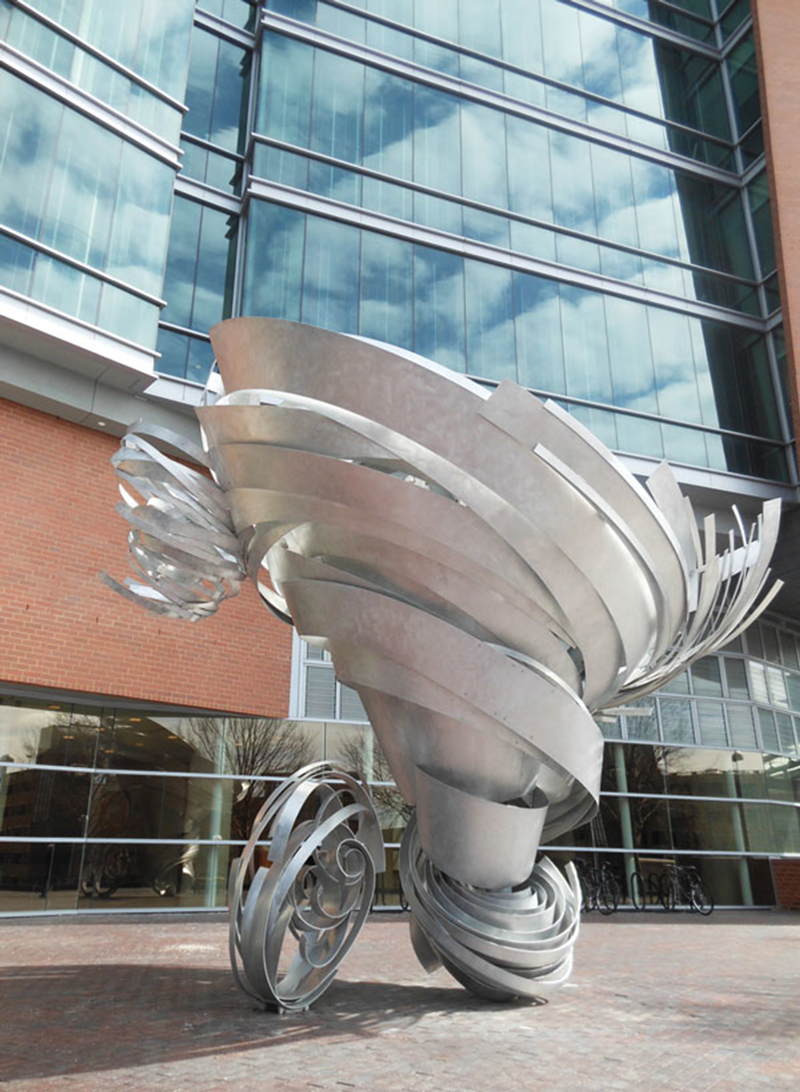For Alice Aycock, whose public sculpture can be found in cities and parks worldwide, “Super Twister” — her new aluminum-and-steel piece at the CARE/Crawley Building on the UC Medical Center campus — represents ideas about chaos she has spent a lifetime pursuing.
The piece’s silver strips, like a twister, build up and widen out from the narrow bottom. They seem to be opening up as they get higher, tearing out in an eruptive manner. Little curlicues of metal spill out, one tipping off of the top while another balances itself precariously on the ground as if ready to roll away.
The New York artist was at the April dedication for the new artwork, which was funded through the Ohio Percent for Art Program. Passed in 1990, that law mandates one percent of the state’s construction budget go toward putting art in any public building that receives state funding and costs $4 million or more.
As interested in science as art, Aycock has tried to create work that captures and understands the properties of chaos, while not itself being chaotic. She’s taken to heart what her mentor, the sculptor Robert Morris, told her about a Jackson Pollock abstract-expressionist painting: “Chaos is just another form of order.”
To her, that could be translated to sculpture that followed a kind of order other than just the traditional grid system of intersecting lines. “But it still had to have a relationship to the world and maybe to science,” she said to attendees of the dedication.
She also fondly recalled one of her early pieces, “Sand/Fans” from 1971, which experimented with structure and chaos. She set up industrial fans near sand and let what happened happen. “It’s still one of my favorite pieces,” she said.
“Super Twister” fits into a period of work for her that she says, “appears to be haphazard and has that underlying structure.” (So, too, do pieces from her current installation along New York’s Park Avenue, “Paper Chase.”)
Aycock’s “Super Twister” is sited on a brick terrace close to the building, but with room to maneuver. You need to get close to really appreciate it from the outside. (UC is working on the entrance from the street to the building.) The sculpture’s biggest drawback is that even at 19 feet in height, it is nevertheless somewhat dwarfed by the architecture until you get up close. Its budget was $278,000.
“Super Twister” is the right kind of piece for the CARE/Crawley Building, which invokes its own sense of chaos, though perhaps not intentionally. The building, completed in 2008, is on the site of a former parking structure and features a nine-story atrium and 240,000-square-feet of space.
Its interior connection to the older Medical Sciences Building might suggest confusion to some — I had to ask directions twice and then follow someone to attend Aycock’s talk in a Medical Sciences lecture hall. (We entered through CARE/Crawley.) The glass-sided atrium itself is exciting in a Metropolis kind of way — there are elevated glass bridges and weird study rooms right in the middle of the ground floor. But it’s hard to get oriented. (It’s a LEED-designated building from STUDIOs Architecture.)
The building does offer a fantastic upper-floor view of “Super Twister.” Ask someone to direct you to Room 4870, if it’s open. From the window here (alas, it’s not a picture window), you can look down toward “Super Twister’s” cone, and it’s like staring into a churning whirlpool. And remember, this is not a kinetic piece with turning parts. The movement is illusory.
The combination of your own height from the ground and the perceived depth of that cone could give a person vertigo. It’s a glimpse into chaos, itself.
Yet, oddly, I found it peaceful — the imaginary circular motion seemed to balance my equilibrium. I felt like George Clooney spacewalking in Gravity — before he got into trouble, that is.
From this location you also get a sense of the piece’s overall scrappiness, with all those strips appearing to curve, bend, merge and split. That’s a lot of action — Pollock would be proud.
You get the notion it was thrown together. Hardly. Aycock explained how she goes on her intuition, trying ideas that her team then works out on computer to see what will work in the real world. It’s as much architecture as art. The finished piece is meant to look like “it just dropped there,” she said.
And it does. But it couldn’t be more painstakingly created.
CONTACT Steven Rosen: [email protected]


